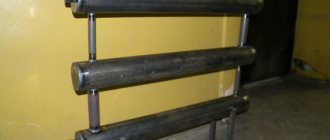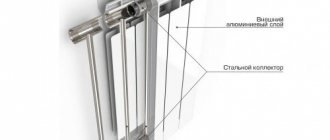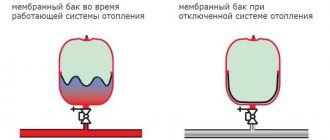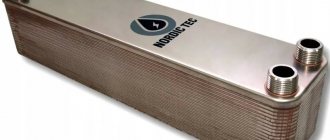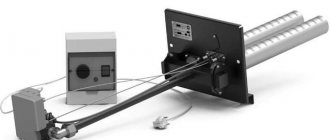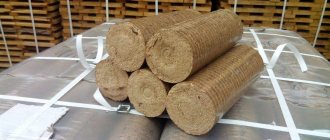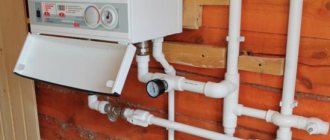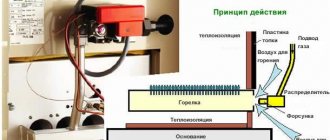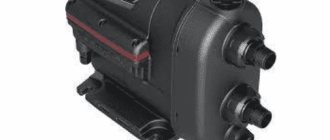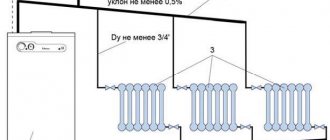How to calculate the heat transfer of heating registers made of smooth pipes? Many builders and designers face this question when selecting heating registers for a specific room. There are certain calculation methods, as well as special applications and programs, for example a heating register power calculator. We will consider them in our article.
One of the simplest and most accessible methods for calculating the heat transfer of registers is calculation in Excel. We have prepared a special document for you that allows you to make these calculations. Using the selected data as an example, we will calculate the heat transfer of a specific register.
Design of heating registers
Heating devices in the form of registers are a structure of several vertical or horizontal pipelines connected to each other using jumpers. In this case, the connecting elements can have different shapes and sizes. Depending on their location, classification is performed.
Register structure
For the manufacture of heating registers, smooth carbon steel pipes with a round cross-section, as well as square and rectangular ones, are used. Their combined use is possible. Stainless and galvanized steel, aluminum, copper, and brass can also be good materials for registers, but they are much more expensive and more difficult to process with your own hands.
Heating registers made of steel profile pipes are considered the simplest to make. They can be made in two main configurations: sectional type and coil type (S-shaped).
In a sectional type register, several sections of profiled metal with capped ends are arranged in parallel and connected to each other by round tubes of smaller cross-section. The jumpers ensure that the rows of the device are filled with coolant from both sides simultaneously. Moreover, the closer to the edge the transition pipes are installed, the higher the heat transfer of the device.
In a coil register, the liquid passes in an S-shape through rows of profile pipes, gradually cooling. To add rigidity to the structure, additional blind jumpers are used. Horizontal rows are connected in pairs by a snake using tubes of a smaller cross-section, like in sectional models, or sections of the main profile. The latter option is preferable due to lower hydraulic resistance and greater heat transfer.
Connecting pipes are made with threads or welding. The most effective option for connecting a heating device is a top-down diagram. For low models and in the case of forced circulation of coolant, entry and exit from below may be justified.
The design of the register must include a Mayevsky valve or an automatic air vent. It is located at the end of the top row on a threaded fitting to allow replacement. A prerequisite for installation is to maintain a slope of 0.05% in the direction of coolant movement.
Registers can be either stationary or portable. The former work as elements of a general heating system, the latter perform the task of local heating. The heat source for a separate mobile register is a heating element with a power of 1.5-6 W, mounted in the housing.
In addition to large horizontal registers, small vertical models are also in demand. If you carry out the work carefully, you can get homemade cheap heating radiators from profile pipes that are almost as aesthetically pleasing as modern sectional radiators.
In some cases, steel registers can be a good addition to the heating units already installed in the room. Despite the lower heat transfer than radiators of a similar size, their use may be more appropriate due to their lower cost.
DIY making
One of the advantages of using registers in heating systems is the possibility of their independent production. For this purpose, round metal pipes are most often used. Despite the fact that the heat transfer coefficient of the heating register in this case will not be perfect, the production process will not require special skills.
To make this heating element yourself, you will need a pipe with a diameter of 40 to 70 mm. The largest cross-sectional value will lead to significant heat losses during coolant circulation.
make a heating device with your own hands according to the following work plan:
- Calculation of the optimal characteristics of the heating device - pipe diameter, total length of the section.
- Formation of a drawing to calculate the optimal amount of material used.
- Carrying out work on the production of a heating register.
- Checking the structure for leaks.
Read also: Diagnostics of the generator voltage regulator
To accomplish this task, you will need a steel pipe specialized for forming the main registers and a line of the smallest diameter. With its help, heating devices will be combined with each other and the heating system. In addition, special end caps for the pipes will be required.
At the first stage , use a grinder to cut the pipes to the required length. It is not recommended to use a welding machine for this, since a weld will form at the ends of the heating register from the convex pipe.
Then holes are made to connect the pipes. The pipes are welded using a welding machine and end caps are installed. To ensure safe operation, the air vent and bleed valve must be identified. They are installed at the top of the system, but on the opposite side relative to the place of connection to the heating.
In some cases, improvements are made to the traditional design of a steel or bimetallic register. It consists of installing an electric heating element. A homemade heating device will produce heat using a heating element. But for this, it is necessary to determine the shut-off valves during installation so that the coolant can circulate only inside the heating device. This makes a good source of heat.
Correct installation of heating devices can be carried out in 2 ways - using threaded connections or using a welding machine. It all depends on the single mass of the structure, its dimensions and the characteristics of the heat supply system. In general, experts advise following the same instructions as when installing radiators.
Heating devices are an essential element of any water heating system. They are usually the most expensive part. A good opportunity to save money would be to use homemade radiators. They are made from smooth round steel pipes or from profile pipes. The latter option is somewhat more expensive, but allows you to reduce the depth of the device and get a more aesthetic appearance.
The use of a profile pipe for the manufacture of heating registers has a number of features. When starting to work with your own hands or deciding to buy a “homemade” product, you need to carefully weigh the pros and cons. Studying the basic rules by which heating registers are made from a profile pipe will help you avoid mistakes when working independently and will make it possible to make a competent choice of the necessary parameters.
How to calculate heat transfer?
The required amount of material can be calculated based on the temperature parameters that need to be obtained in the room. At the household level, this step is usually skipped - they make heating registers with their own hands “by eye” according to the principle “the more, the better.”
But it is better to make simple calculations of heat transfer, for which you do not need to be a mathematician. All you need is:
- Calculate the area of the room.
- Learn about the heat transfer properties of steel.
- Select the optimal pipe diameter.
The area of a room is calculated by multiplying its length by its width (S = L*W). However, for more accurate calculations, it is recommended to calculate the volumetric parameter by adding the height (H) value to the calculations.
So, the final calculation formula takes the form:
V = L*W*H
For example, you need to calculate V of a room where the length is 5 m, width is 3 m, height is 2.15 m. The volume of the room is obtained: V = 5*3*2.15 = 30.25 m3. Based on this basic value, further calculations should be made to determine the amount of heat, the size and number of heating registers to make with your own hands.
Self-welded heating registers are blocks consisting of six steel pipes with a diameter of over 100 mm. Such batteries, made without proper calculations, can overheat the room being served.
First of all, the required amount of heat per calculated volume of the room is calculated to achieve the required internal temperature (W):
Qп.т = V * k (Tin – Tout),
where V is the volume of the room; k – heat transfer coefficient of the building walls; Tin – temperature inside; Tout – outside temperature.
The amount of heat generated by one register can be calculated using the formula:
Qр = q * L * (1-n),
where: q – heat flow from each horizontal and vertical pipe of the register (approximately 20-30 W/m); L – length of vertical and horizontal pipes of the register (m); n – coefficient of unaccounted heat flows (for metal pipes – 0.1).
The category of unaccounted heat loss also includes the hood in the garage. If the mechanical type is installed, the coefficient n must be increased to at least 0.2.
The number of registers, accordingly, is determined by the formula:
Nр = Qп.т. / Qр
Such a calculation method will most likely be assessed by design specialists as a simplified and crude form. However, this approach still seems to be a more rational action than calculating and making registers with your own hands by eye, without any calculations.
What are there
Heating registers are made of different materials and have different shapes. Each has pros and cons.
What are they made from?
If we talk about materials, the most common is steel, or rather electric-welded steel pipes. Steel does not have the best heat transfer, but this is compensated by its low price, ease of processing, availability and a large selection of standard sizes.
It is very rare to find pipes made of stainless steel - for decent power a large number of pipes are required, and you have an idea how much stainless steel products cost. If they did, it was probably a long time ago. They also use galvanized steel, but it is more difficult to work with - you won’t be able to cook it.
- Requires neutral and clean coolant, free of solid particles
- the presence of other metals and alloys in the system is undesirable, except for compatible ones - bronze, brass, nickel, chromium, therefore all fittings and fittings will need to be made from these materials;
- Careful grounding is mandatory - without it, in the presence of water, electrochemical corrosion processes begin;
- the softness of the material requires protection - covers are needed, etc.
There are registers made of cast iron. But they are too bulky. In addition, they have a very large mass; no less massive racks need to be made for them. Plus, cast iron is fragile - one blow and it can crack. It turns out that this type of registers also needs protective covers, and they reduce heat transfer and increase cost. Moreover, installing them is complex and hard work. The advantages include high reliability and chemical neutrality: this alloy does not care what coolant it works with.
In general, copper and cast iron are not easy. So it turns out that the optimal choice is steel registers.
How the device works
There are several options for connecting and arranging heating registers: sectional and coil. The most popular at the moment is the first option, in which the pipes are connected to each other by tubes of smaller diameter. The connection is made in such a way that the coolant can flow freely through all pipes and sections.
If we consider a connection in the form of a coil, it should be noted that it is also built from rows of pipes running parallel to each other. However, the difference here is that each of them is connected to the next one by a transition roll, equal in diameter to the section itself. Due to this design, the entire surface area is involved in the process, which significantly improves the heat transfer process. In addition, there are no areas of narrowing of the pipes, which reduces the hydraulic resistance in the heating register itself.
Materials for production
The materials used for the production of registers are VGP pipes and electric-welded steel pipes (according to GOST 10704−91 and others). The alloy has absolutely all the data needed for heating devices: resistance to high temperatures and pressure, the smallest thermal increase (in the established temperature range), significant thermal conductivity, shock resistance (which is important when used in industrial premises), and a long period of operation in heating systems.
In order to ensure the quality of welding and the reliability of the seams, the finished heating registers are subjected to pressing and hydraulic tests. The pointer is filled with liquid, and excess pressure is reached, usually 1.6 MPa. If a leak is detected, the liquid is combined, the detected holes are welded, after which the process is repeated.
Reduced heat transfer.
In order to save energy, it becomes important to reduce the heat transfer of pipes in those sections of communications that are not used for their intended purpose, for example, when moving from one building to another or in an unheated room.
There are many options for using thermal insulation materials for this. Manufacturers offer a fairly wide range to choose from, ranging from cheap fiberglass to more expensive types of polystyrene foam. You can purchase pipes with insulating elements already built into them.
To summarize, we conclude that the use of such calculations helps to significantly save money and avoid many technical obstacles when designing water and heat supply systems.
Actually, you are a desperate person if you decide to undertake such an event. The heat transfer of a pipe, of course, can be calculated and there are a great many works on the theoretical calculation of the heat transfer of various pipes.
Let's start with the fact that if you decided to heat your house with your own hands, then you are a stubborn and purposeful person. Accordingly, a heating project has already been drawn up, pipes have been selected: either metal-plastic heating pipes or steel heating pipes. Heating radiators have also already been looked at in the store.
But, before acquiring all this, that is, at the design stage, it is necessary to make a conditional relative calculation. After all, the heat transfer of heating pipes, calculated in the project, is the key to warm winters for your family. There is no room for error here.
Methods for calculating heat transfer from heating pipes
Why is the emphasis usually placed on calculating the heat transfer of heating pipes? The fact is that for commercially manufactured heating radiators, all these calculations have been made and are given in the instructions for use of the products. Based on them, you can easily calculate the required number of radiators depending on the parameters of your home: volume, coolant temperature, etc.
Tables.
This is the quintessence of all the necessary parameters collected in one place. Today the Internet contains a great many tables and reference books for online calculations of heat transfer from pipes. In them you will learn what is the heat transfer of a steel pipe or cast iron pipe, the heat transfer of a polymer or copper pipe.
All that is needed when using these tables is to know the initial parameters of your pipe: material, wall thickness, internal diameter, etc. And, accordingly, enter into the search the query “Table of heat transfer coefficients of pipes.”
This section on determining the heat transfer of pipes also includes the use of manual reference books on heat transfer of materials. Although they are becoming more and more difficult to find, all information has migrated to the Internet.
Formulas.
The heat transfer of a steel pipe is calculated according to the formula
Qtr=1.163*Str*k*(Twater - Air)*(1-efficiency of pipe insulation), W where Str is the surface area of the pipe, and k is the heat transfer coefficient from water to air.
The heat transfer of a metal-plastic pipe is calculated using a different formula.
Where is the temperature on the inner surface of the pipeline, °C; t
c is the temperature on the outer surface of the pipeline, °C;
Q—
heat flow, W;
l
—pipe length, m;
t
—coolant temperature, °C;
t
inc—air temperature, °C;
a n is the external heat transfer coefficient, W/m 2 K; d
n - outer diameter of the pipe, mm;
l—thermal conductivity coefficient, W/m K; d
in
-
internal diameter of the pipe, mm; a int - internal heat transfer coefficient, W/m 2 K;
You understand perfectly well that calculating the thermal conductivity of heating pipes is a relative value. The formulas include the average parameters of certain indicators, which may, and do, differ from those that actually exist.
For example, as a result of the experiments, it was found that the heat transfer of a polypropylene pipe located horizontally is slightly lower than that of steel pipes of the same internal diameter, by 7-8%. It is internal, since polymer pipes have a slightly thicker wall thickness.
Many factors influence the final figures obtained in tables and formulas, which is why the footnote “approximate heat transfer” is always included. After all, the formulas do not take into account, for example, heat loss through the building envelope made of different materials. There are corresponding tables of amendments for this purpose.
However, by using one of the methods for determining the heat output of heating pipes, you will have a general idea of what kind of heating pipes and radiators you need for your home.
Good luck to you, builders of your warm present and future.
Video description
An example of how to calculate heating in a private house using an online calculator in this video:
Device characteristics
Heating registers have several qualities that distinguish them from other heating devices:
- Thanks to effective heat exchange with the surrounding space, small-sized devices are able to heat large rooms.
- Making a heat exchanger is quite simple - you only need a welding machine and an angle grinder with a cutting disc.
- You can use any available materials - pipes made of cast iron, stainless steel or steel.
- The devices are able to withstand high pressure (10 kgf/m2) and can operate on any coolant - water, oil, other liquids, steam.
- The device can be assembled either according to ready-made drawings or according to those drawn up independently. Various configuration options, plugs, additional elements and finishing materials are allowed.
- The final cost of a heat exchanger made of smooth pipes will be lower than that of other devices with a similar level of efficiency.
It is worth noting that the larger the total surface area of the device, the higher its heat transfer. In turn, the area depends on the cross-section of the pipe and the length of the section.
In most cases, heating registers have the following characteristics:
- Electric-welded carbon steel pipes are used for the heat exchanger.
- The pipes are connected in one of the following ways: flanged, external threaded, and welded.
- The maximum pressure value is 10 kgf/m2.
- The cross-section of pipes in sections is 32-219 mm.
- The minimum distance between levels is 50 mm.
- The cross-section of the connecting jumpers is from 32mm.
Coil
Unlike a sectional one, a coil heat exchanger consists of one long pipe, bent in the shape of the letter S. It uses pipes of a similar cross-section, and there are no areas of narrowing.
Thanks to the special shape of the design, the heat transfer of heating registers of this type increases and the hydraulic resistance of the coolant decreases.
In most cases, heating registers are made of smooth-walled high-carbon steel pipes. However, you can also find devices made of stainless or low-alloy steel, as well as cast iron.
Thanks to the use of heating registers, even if they are of a compact size, high heating efficiency can be achieved. In this regard, these devices are actively used in large industrial and warehouse premises.
It is worth noting that the use of registers is especially important in premises that are subject to increased sanitary and fire safety requirements.
Calculation of registers from smooth pipes
Steel heating registers are easy to make with your own hands. The cost of such a heating system will depend on who will cook them. If you own the welding technique yourself, the option is the most low-budget; if the welder needs to be paid, there will not be much difference in cost with inexpensive aluminum ones.
In this case, the registers will occupy larger areas than standard heating devices: due to the small surface of contact with air, their efficiency is low. They increase heat transfer by installing a more powerful pump, but there are speed restrictions due to possible noise in the system. Read about how to select the pump power here.
Diameters, as mentioned, range from 32 mm to 100-150 mm. Large pipe sizes lead to an increase in system volume. When starting and accelerating the system, this is a minus - it will take quite some time until the coolant heats up. When working, a large volume is rather a plus: milder conditions for the boiler. On the other hand, with a large amount of coolant, it is difficult to regulate the temperature.
Table of heat transfer of steel pipes of different diameters for different operating conditions of the system (click on the picture to enlarge its size)
The distance between two pipes in the register should not be small: this reduces heat transfer. Therefore, they are located at a distance of no less than 1.5 radii. The number of rows and register length depend on the required power, as well as the diameter of the selected pipes. In the general case (for central Russia, for rooms with average thermal insulation and a ceiling height of 3 m), it can be calculated by the heat transfer of a meter of steel pipe. These values are given in the table. Using it you can find the size and number of registers by area of the room.
Heat transfer of one meter of steel pipes of different diameters - to calculate the heating register by area
To calculate the heat losses of a room, there are averaged data on the thermal power of a linear meter of steel pipe. You can use them for standard conditions. If the system operates at other temperatures, adjustments may need to be made up or down.
If these tables did not help you, you can calculate the register using the formula.
Formula for calculating registers made of steel pipes
By substituting the appropriate values, you will find the heat transfer of one pipe under your conditions. The heat transfer of all subsequent ones (second or more) will be slightly less. The found value must be multiplied by 0.9. So you will calculate and be able to make a register from smooth pipes with your own hands.
Heat exchanger installation
Considering the large weight of the heating register, you need to use appropriate brackets for mounting, or better yet, place it on the floor. As you understand, there are two installation methods:
- hang on the wall;
- put it on the floor.
The main thing is that the structure is very strong. The distance to the walls is also important, which is 20–25 cm. The same distance should be to the floor, while maintaining the intended slope angle for circulation. The distance between the heating register pipes must be at least five centimeters. It doesn’t matter whether the heat exchanger is autonomous or connected to a network.
Radiators of any type are installed around the perimeter of the room on the external walls. That is why in apartments the battery is always under the window. The heat exchanger not only heats the air, it also heats the walls
It is very important to paint the registers so that they do not rust
Hydraulic calculation
This scheme requires calculation of the power of the circulation pump depending on the length of the line
An important component of the circuit is a hydraulic pump, which creates supply pressure and vacuum on the return path. The calculation data demonstrate that the values of both parameters decrease as the distance from the pump increases in the direction of coolant movement. If you measure the data on a hundred-meter pipe, it turns out that when removed by 10 m, the supply pressure will be 90% of the nominal value, and the reverse vacuum will be 5%. With a range of 20 m, these parameters will be equal to 75% and 20%, respectively, and the drop on the radiator element in both cases will be 95%. At a distance of 50-60 m, the numbers shift to the middle (45 and 40, 40 and 45, respectively), and the decline on the radiator is 85%. With further distance from the pump, the proportions continue to change towards increasing vacuum; the pressure reduction at a distance of 70 m will be 90%, and at 80 m and more – 95%. Thus, in the middle part the pressure loss will be slightly greater than at the beginning and end. Proportionally changing indicators make it possible to maintain approximately equal radiator pressure drops.
Bimetallic batteries
These radiators are made of a steel core inside and aluminum fins outside. The high strength of the batteries is achieved by the presence of steel inside. Most models are tested under pressure of 60 and even 150 atmospheres. They also have good chemical stability.
The high heat transfer of bimetallic radiators is due to aluminum fins with a significant surface area. Due to the small cross-section of the channels inside the sections, a high speed of coolant movement is ensured and there is no need for frequent flushing. The main disadvantage of bimetallic radiators is their high cost. Thus, a ten-section bimetallic battery will cost several times more than other options.
How to install a heating register
Every owner can install a heating register without involving a specialist in the work. To simplify assembly operations, it is first necessary to prepare each element of the heating system according to the project.
One of the main requirements is a high-quality connection of the register with pipelines. It must withstand the maximum permissible load - 10 MPa. If the joining is done by welding, you need to monitor the quality of the seams.
It is recommended to place registers along one wall. In this case, a minimum slope in the direction of movement of the coolant is required - up to 0.05% of the length of the device.
Heating registers must be located closer to the floor surface. The larger the diameter of the main pipe, the less resistance there will be for the circulating coolant.
The efficiency of the device depends on a large number of factors, including the heating area, which is directly proportional to the length and diameter of the pipes. The most widely used models in everyday life are those with the following characteristics:
- Recommended pipe diameter – from 25 to 160 mm
- Connecting jumpers for sectional models – from 30 mm
- Distance between main pipes – from 50 mm
- Maximum pressure – 10 MPa
- Material – high carbon steel
We make a register with our own hands
Anyone who knows how to work with a welding machine is able to make a heating register on their own. The simple design can be filled with antifreeze or oil.
Introductory video on production
To make a heating device with your own hands, it is recommended to follow the instructions:
- It is necessary to prepare pipes of suitable diameters and cut the blanks
- The inside of the pipe is checked and, if necessary, cleaned to reduce the already high resistance to the circulating coolant
- Plugs are welded at the ends, holes are drilled in some of them
Tubes of a smaller diameter (vertical) are connected to thicker ones (horizontal). It is necessary to install taps to remove air that will accumulate from the edges. All seams are carefully and efficiently cleaned, the surface is painted with oil paints.
In portable structures, it is necessary to install a heating element with a power of 1.5 to 6 W, which will operate from a regular outlet. If the system is powered by a heating boiler, the efficiency of the registers can be increased by installing a powerful circulation pump.
Main advantages
Among the many advantages of heating registers are:
- It is possible to order the production of heating devices according to the customer’s individual drawings
- Inside them, not only liquid, but also hot steam can act as a coolant.
Installation does not require special equipment Can be installed in rooms with a large area, as they are characterized by effective heat exchange despite their compact and modest size Reasonable cost
In custody
Of course, heating registers are replacing classic heating radiators. In private homes, they can be found in rooms with more aggressive conditions (toilet, bathroom, periodically unheated rooms, etc.). It will not be difficult for a good craftsman to make such a device on his own.
A heating device consisting of smooth-walled pipes connected by welding is called a register. Basically, pipes located horizontally are connected by vertical short jumpers, through which the coolant also passes. The design of the registers underlies the creation of different types of heating radiators.
Connection
Connecting devices to the heating system can be done using welding, threaded and flange connections - the selection of one or another type of connection depends on the useful features of the heating system. If the device consists of a significant number of parts and pipes of larger diameter, it is important to use stands and fasteners that support the register not only at the bottom, but also in the middle, in order to share the weight and not form an excessive load on the lower sector. Please note that for best performance, it is preferable to install the register closer to the floor.
Types of finned pipes
Ribbed pipe heating elements are made of the following metals:
- cast iron (with additions of magnesium and cerium);
- steel;
- stainless steel;
- copper;
- brass;
- aluminum.
According to the structure of the structure, finned pipes are divided into:
- monometallic - solid products obtained by casting or turning from a workpiece;
- bimetallic - products assembled from pipes and ribs.
Monometallic products include cast iron finned pipes, which are manufactured by casting and must meet the requirements of GOST 1816-76, as well as copper and aluminum products, on which the ribs are formed by extrusion/rolling on a machine.
A bimetallic product is an internal supporting pipe made of stainless steel or brass, on which longitudinal or transverse copper or aluminum ribs are located.
Finning of bimetallic pipes is carried out using the following methods:
- rolling - an aluminum or copper coupling is put on the supporting pipe, on which the ribs are extruded using the rolling method;
- spiral-helical winding - a metal strip is pressed into the outer surface of the supporting pipe during spiral winding;
- spiral-screw HDTV - fastening the tape to the supporting pipe by welding the contact surfaces after they are heated by high-frequency current;
- longitudinal (axial) fins – connecting the strip to the supporting pipe using one of the types of welding.
When manufacturing bimetallic pipe registers for heat exchangers, the layout of materials can be as follows (carrying pipe + fins):
- steel + aluminum;
- aluminum + aluminum;
- brass + aluminum
Technical characteristics of cast iron ribbed pipes
Cast iron is a strong and durable metal with high thermal conductivity, therefore cast iron finned pipes are most common in heating systems, which are characterized by the following parameters:
- internal diameter – from 32 to 70.0 mm;
- outer diameter (with ribs) – 175.0 mm;
- operating operating temperature – up to 90 degrees. (short-term exposure up to 150 degrees),
- operating coolant pressure in the system – 1.0 MPa;
- the length of individual elements is from 0.5 to 6.0 m.
The shape of the ribs can be round or rectangular. The rectangular format of finned heating pipes is more efficient due to the larger heat transfer surface area.
Adviсe
Before you start making registers, you should take care of purchasing the appropriate materials. You will need pipes of one diameter or another and some length. Exact numbers are not given here, since the device of the type in question can be assembled from any pipes without focusing on their diameter and thickness
More important is to ensure optimal heat transfer, which involves carrying out calculations regarding the required surface area of the register
To do this, you will need to determine the outer area of the entire system. The resulting value is then multiplied by 330 W. The use of this method is based on the statement that 1 m2 gives off 330 W of heat if the temperature of the medium is 60 °C and the air inside the heated room is 18 °C.
For people skilled in welding, assembling the structure will not be difficult. It will be necessary to prepare pipes and cut them into sections, and also take care of the plugs, for the manufacture of which a steel sheet will be required. Register assembly does not imply the presence of a strictly defined order of actions. Upon completion of welding work, it is necessary to ensure the tightness of the created structure. Otherwise, the following advice can be given:
- you should select pipes with an optimal wall thickness, since too thin ones cool quickly enough, and thick ones take a long time to warm up;
- the upper section must be supplemented with a Mayevsky valve, with the help of which air is released;
- assembly of the register in the form of a coil involves the use of a pipe bender; if this is not possible, the rotary sections can be assembled from ready-made elbows;
- the coolant inlet must be equipped with a tap, and the outlet with a valve;
- The installation of the register should be carried out with a slight slope in the direction where the supply pipe is located, which ensures that the Mayevsky crane occupies the highest position.
Types of heating registers
Heating registers are a group of pipelines located parallel to each other and communicating with each other. They may differ in material, shape and design.
Materials for production
Most often, heating registers are made of smooth steel pipes in accordance with GOST 3262-75 or GOST 10704-91. The use of electric welded pipes is preferable due to their ability to withstand higher pressures. However, in practice, water and gas pipes are also quite common, and they are operated no less successfully. Such heating devices can easily withstand all kinds of mechanical damage and loads, as well as work with any coolant.
There are also stainless steel models. They are installed in rooms with increased requirements for aesthetics and durability. Due to the increased cost, the use of stainless steel registers is most justified in bathrooms. The high corrosion resistance and variety of configurations of stainless steel heated towel rails allow them to be used even in the most modern bathroom interiors.
Aluminum and bimetallic registers are more efficient in terms of heat transfer. They are lightweight and aesthetically pleasing, and work perfectly in individual heating systems with well-organized water treatment. In other cases, low quality coolant leads to rapid failure of devices.
Sometimes you can find registers made of copper. They are usually used in systems where the main wiring is copper. They are easy to work with, very attractive and durable. In addition, the thermal conductivity of copper is approximately 8 times higher than steel, which makes it possible to significantly reduce the size of the heating surface. A common disadvantage of all devices made of non-ferrous metals - sensitivity to operating conditions - limits the scope of application of copper registers.
Design
The most characteristic designs of traditional steel registers can be divided into 2 types:
- Sectional;
- Serpentine.
The first is characterized by a horizontal arrangement of pipelines and the use of vertical narrow jumpers between them. The second involves the use of straight and arcuate elements of the same diameter, which are connected by a snake using welding. When using stainless steel or non-ferrous metals, the pipes are simply bent to give the required configuration.
There are three options for connecting pipes:
- Threaded;
- Flanged;
- For welding.
They can be located either on one side of the device or on different ones. The coolant outlet is provided under the supply or diagonally from it. Sometimes there is a lower connection of lines, but in this case the heat transfer is significantly reduced.
In sectional registers, there are 2 types of connections depending on the method of arranging jumpers:
- "Thread";
- "Column".
Plain tube registers can be used as registers for the main heating system or as separate heaters. For autonomous operation, a heating element of the required power is installed inside the device and connected to the network. Antifreeze or oil is often used as a coolant for portable electrical registers made of steel, because... it does not freeze during storage or during a power outage.
When used separately from the general heating system, it is necessary to additionally place the expansion tank in the upper part of the device. This avoids pressure increases due to volume expansion during heating. The size of the container is selected based on the ability to accommodate about 10% of the total amount of liquid in the heater.
For autonomous use of the register made of steel pipes, legs with a height of 200 - 250 mm are welded to it. If the device is part of a heating circuit, its movement is not planned and the walls are strong enough, then a stationary mount is used using brackets. Sometimes for very massive registers a combined installation option is used, i.e. The device is placed on stands and additionally fixed on the wall.
Advantages and disadvantages of devices
Homemade metal or aluminum devices differ from conventional radiators in their dimensions. They consist of some pipes whose diameter exceeds 32 mm. To organize the circulation of the coolant, the pipes are connected to each other by pipes.
What is the reason for the popularity of these heat supply devices? First of all, the prospect of independent production. You can make bimetallic devices, metal or aluminum pipes.
Before connecting the heating registers, you should carefully study all their sides.
Advantages:
- Long service life. For metal and aluminum modifications it can reach 25 years. In this case, the possibility of breakdown will be minimal.
- Significant heat dissipation. This is due to the fact that the power of the devices exceeds this parameter of traditional radiators and batteries. Due to the large size of the coolant.
- Easy installation and operation. Since anyone who is at least a little familiar with the instructions for organizing heat supply can correctly identify the devices, they can be used in buildings of all types. But most often they can be found in the heating system of industrial, administrative and commercial premises.
Read also: Welding with flux-cored wire in a shielded gas environment
But, in addition to this, it is necessary to take into account the possible disadvantages that a register made of a smooth metal pipe may have:
- Large coolant size. This leads to its rapid cooling.
- Lowest rate of air convection. Reduces the efficiency of heat supply.
- Unsightly appearance. Most often this applies to homemade systems.
Correctly calculated heating heat transfer directly depends on the design of the device. Currently, a number of types of these heat supply devices are used, differing not only in the production material used, but also in appearance.
Calculation of heating registers - how to calculate correctly
When deciding to install this type of heat exchanger in your apartment, you should decide how to calculate heating registers.
For these purposes, use the following formula:
Q = πdнLk(tg - to)×(1 - ηiz), in which:
π = 3.14 – constant value;
dн – external section of the pipe, m;
L – length of the segment, m;
tо – air temperature in the building in which the register will be installed;
tr – temperature of water circulating in the pipeline;
k is the heat transfer coefficient, the value of which is 11.63 W/m2℃;
ηiz – heat transfer coefficient of insulation. If the device is isolated, the value of ηiz = 0.6-0.8. In devices without insulation, this coefficient is zero.
Let's calculate the heating registers for a pipe with a cross-section of 159 mm and a length of 5 m. The water temperature in the circuit is 80 ℃, and the air temperature in the room is 23 ℃.
Q=3.14×0.159×5×11.63×(80-23)×(1-0)=1654.8 W.
The result of calculating registers made of smooth pipes for heating showed the power of a heat exchanger that uses one horizontal pipe. If it consists of several rows, a reduction factor of 0.9 is applied for each subsequent level.
In order not to go into details of how to calculate the number of heating registers, you can use online calculators, but their results quite often remain far from the truth. In this regard, it is advisable to still understand the formula and calculate heating registers from pipes in order to check how correct the result is produced by the calculator.
When installing heating registers, you should adhere to the requirements of GOST. Since the connection must be strong and reliable, in order to withstand the weight of the device with the coolant inside, a welding machine is required.
Calculation
There are methods for calculating the characteristics of heating devices. They are distinguished by the accuracy of their calculations. However, to organize heat supply with the support of metal or aluminum heating registers, it is recommended to seek the services of specialists. Another option is to use special software .
However, in some cases it is necessary to properly think through the heating device yourself. To do this, you can use a simple diagram. You should first know the following characteristics:
- The general area of the heated building.
- The heat transfer coefficient of the register material used.
- Diameter of pipes used for manufacturing
Knowing the characteristics, you can calculate the power of the device.
Calculation of registers made of smooth pipes , their quantity and parameters required for heating a particular building can only be carried out approximately with a significant degree of error. This is explained by a large number of conditions on which the temperature in the room depends, such as: wall thickness, the thermal insulation properties of the room, the number and area of openings (and, in addition, the total area of the cracks in them), ventilation intensity, outside air temperature, wind speed.
Therefore, it is more correct to plan the number of parts in the registers and the number of heating devices themselves “with a reserve”, and you can control the temperature in the room by changing the operating modes of the heating boiler. However, there is an unofficial standard: for heating 1 sq. meter of a building with a ceiling height of 3 meters requires 1 meter of pipe with a diameter of 60 mm.
Calculations
Why do you need to calculate the heating register? Let's start from afar.
What specific characteristics of a heating device should be taken into account when choosing it?
- Operating pressure. For a welded register, it obviously exceeds the central heating parameters and allows it to withstand any hydraulic shock.
- Operating temperature. As you might guess, there are no special restrictions here either.
- Thermal power. It is selected depending on the volume of the room. A lack of thermal power indicates that the house will be cold, an excess indicates that you will have to constantly keep the windows open and endure drafts.
How are heating registers calculated for a metal round pipe of known diameter?
The following formula applies here:
Q = Pi*Dн *L * k * Dt, where:
- Q is the heat flow of the section in watts.
- Pi - the number 'pi', taken equal to 3.1415,
- Dн is the outer diameter of the pipe in meters.
- L is the length of the section in meters.
- k is the thermal conductivity coefficient of a metal pipe, taken equal to 11.63 W/m2*C.
- Dt is the temperature delta between the air and the coolant in the room.
A fundamental point: this is how the heat flow is calculated for one horizontal pipe. In a multi-row register, for all sections, not counting the first, an additional coefficient of 0.9 is used: since they are located in the upward flow of warm air from the first pipe, which reduces the temperature delta.
How to convert the pipe diameter indicated by the seller in inches into the usual values? Here is the size chart:
| Size in inches | DN (conditional passage) |
| 1 | 25 |
| 1 1/4 | 32 |
| 1 1/2 | 40 |
| 2 | 50 |
| 2 1/2 | 65 |
| 3 | 89 |
| 4 | 100 |
| 5 | 125 |
| 6 | 150 |
| 8 | 200 |
Please note: DN approximately corresponds to the internal diameter. To obtain an external one, you need to add twice the thickness of the pipe wall
Let's evaluate the heat transfer of a four-row register made of a pipe with an outer diameter of 108 mm and a length of 1.2 meters at its temperature of +80 C and the air temperature in the room of +20 C.
- For the first section, the heat flux is 3.1415*0.108*1.2*11.63*(80-20)=284 watts.
- For each subsequent one it is multiplied by 0.9. 284*0.9=255.
- The total value is 284+(255*3) = 1049 watts.
Advantages of the equipment
The main advantages of this type of heat exchanger can be considered:
- ease of use;
- ease of maintenance (cleaning);
- the presence of a large heat-transfer area with small dimensions;
- high fire safety;
- economical energy consumption in the presence of a heating element;
- Possibility of use as a heated towel rail;
- Wide range of applications - can be installed in warehouses, production workshops, trade pavilions and office buildings, as well as in hospitals and clinics.
conclusions
If you decide to equip your home with this type of heating device, we advise you to carefully understand the features of its operation, as well as study the intricacies of creating and installing registers. Additional reference literature will greatly help you with this.
A heating register of four smooth pipes and a flow diagram of the coolant are shown in the figure below.
We turn on the computer, MS Office and start the calculation in Excel.
Initial data:
There is not a lot of initial data, they are clear and simple.
- Pipe diameter D
in mm is entered
to cell D3: 108,0
- the length of the register (one pipe) L
in m
to cell D4: 1,250
- the number of pipes in register N
in pieces
to cell D5: 4
- the “supply” water temperature tp
in °C
to cell D6: 85
- the return water temperature tо
in °C
to cell D7: 60
Enter the room air temperature t
to cell D8: 18
- Select the type of outer surface of the pipes from the drop-down list
in merged cells C9D9E9: “In theoretical calculation”
- the Stefan-Boltzmann constant C 0
in W/(m 2 * K 4)
to cell D10: 0,00000005669
- the value of free fall acceleration g
in m/s 2
to cell D11: 9,80665
By changing the initial data, you can simulate any “temperature situation” for any standard size of the heating register!
The heat transfer of just a single horizontal pipe can also be easily calculated using this program! To do this, it is enough to indicate the number of pipes in the heating register equal to one (N=1).
Calculation results:
- The degree of emissivity of the radiating surfaces of pipes ε
is automatically determined by the selected type of outer surface
In the database, located on the same sheet with the calculation program, 27 types of external surfaces of pipes and their degree of emissivity are presented for selection. (See the download file at the end of the article.)
- The average temperature of the pipe walls tst
in °C is calculated
in cell D14: =(D6+D7)/2 =72,5
t st =(t p +t o)/2
- temperature difference dt
in °C
in cell D15: =D14-D8 =54,5
dt=t st - t in
- The coefficient of volumetric expansion of air β
in 1/K is determined
in cell D16: =1/(D8+273) =0,003436
β=1/(t in +273)
- the kinematic viscosity of air ν
in m 2 /s
in cell D17: =0.0000000001192*D8^2+0.000000086895*D8+0.000013306 =0,00001491
ν=0.0000000001192*t in 2 +0.000000086895*t in +0.000013306
- Prandtl criterion Pr
is determined
in cell D18: =0.00000073*D8^2-0.00028085*D8+0.70934 =0,7045
Pr=0.00000073*t in 2 -0.00028085*t in +0.70934
- 16.
Calculate the thermal conductivity coefficient of air
λ
in cell D19: =-0.000000022042*D8^2+0.0000793717*D8+0.0243834 =0,02580
λ
=
-0,000000022042*t in 2 +0.0000793717*t in +0.0243834
- A
pipes in m 2 is determined
in cell D20: =PI()*D3/1000*D4*D5 =1,6965
A=π*(D/1000)*L*N
- The heat flux of radiation from the surfaces of the pipes of the heating register Q and
in W is calculated
in cell D21: =D10*D13*D20*((D14+273)^4- (D8+273)^4)*0.93^(D5-1) =444
Q and =C 0 *ε *A*((t st +273) 4 - (t st +273) 4)*0.93 (N-1)
- the heat transfer coefficient for radiation α and
in W/(m 2 *K)
in cell D22: =D21/(D15*D20) =4,8
α and =Q and /(dt*A)
- Grashof criterion Gr
is calculated
in cell D23: =D11*D16*(D3/1000)^3*D15/D17^2 =10410000
Gr=g*β*(D/1000) 3 *dt/ν 2
We find the Nusselt criterion Nu
in cell D24: =0.5*(D23*D18)^0.25 =26,0194
Nu=0.5*(Gr*Pr) 0.25
- the convective component of the heat flow Q k
in W
in cell D25: =D26*D20*D15 =462
Q to =α to *A*dt
- And the heat transfer coefficient during convection α k
in W/(m 2 *K) is determined accordingly
in cell D26: =D24*D19/(D3/1000)*0.93^(D5-1) =5,0
α to =Nu*λ/(D/1000)*0.93 (N-1)
- the total heat flow power of the heating register Q
in W and Kcal/hour, respectively
in cell D27: =(D21+D25)/1000 =0,906
Q=(Q and +Q k)/1000
and in cell D28: =D27*0.85985 =0,779
Q'=Q*0.85985
- the heat transfer coefficient from the surfaces of the heating register to the air α
in W/(m2*K) and Kcal/(hour*m2*K) respectively
in cell D29: =D22+D26 =9,8
α=α and +α to
and in cell D30: =D29*0.85985 =8,4
α'=α*0.85985
This completes the calculation in Excel. Heat transfer from the heating register from the pipes has been found!
The calculations have been repeatedly confirmed by practice!
Plugging into the system
The technology for connecting home-welded registers will depend primarily on the design features of the home heating system itself. When making a saddle insert, holes are pre-made in the lower section of the device along the edges. Next, the supply and return are connected and the bypass is welded.
For diagonal or lateral connections, holes are cut in the appropriate places in the plugs. To connect the return and supply in this case, steel corner fittings can also be used.
The heating system register is a device made of smooth-walled pipelines. Due to its design features, the register served as the basis for most radiators. Very often, these devices are located in technical and industrial premises. In addition, there are often cases when they are installed in apartments as part of autonomous heating systems. However, not everyone knows how to calculate the heat transfer of a register.
